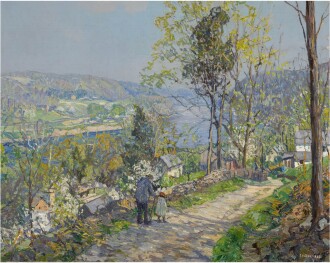Works by Edward Willis Redfield at Sotheby's
Edward Willis Redfield Biography
Born in Bridgeville Delaware in 1869, Edward Willis Redfield was an American Impressionist painter best known for his pastoral and snowy scenes of the Northeast countryside. Widely regarded as one of the pioneering members of the New Hope Circle, Redfield worked alongside artists such as Daniel Garber, Walter Schofield and Robert Spencer. Renowned for his dynamic and lively renderings of the rural scenery which surrounded him, his en plein air works have become synonymous with the unsentimental individualism characteristic of early twentieth century American landscape painting.
Edward Redfield's impressionist landscapes are distinguished by their bold layers of impasto and vibrant color scheme. Preferring to paint from life, Redfield would often brave whatever harsh weather conditions came his way in order to work outside rather than in his studio. To prevent his canvases from being blown away, he would often tether them to the trunks of trees while he worked. As a consequence of his en plein air methods, he developed a knack for very agile, efficient painting, completing his canvases within the span of only a few hours.
Widely regarded as the leading American painter of winter scenes in the 20th century, Redfield is accredited with receiving more awards than any American painter, second only to John Singer Sargent. His works have been widely exhibited, and his paintings were featured in significant exhibitions of the early 20th century, including the 1915 Panama-Pacific International Exposition in San Francisco. Today, Redfield’s works reside in the public collections of the Metropolitan Museum of Art in New York City and the Smithsonian American Art Museum in Washington, DC., to name a few.












